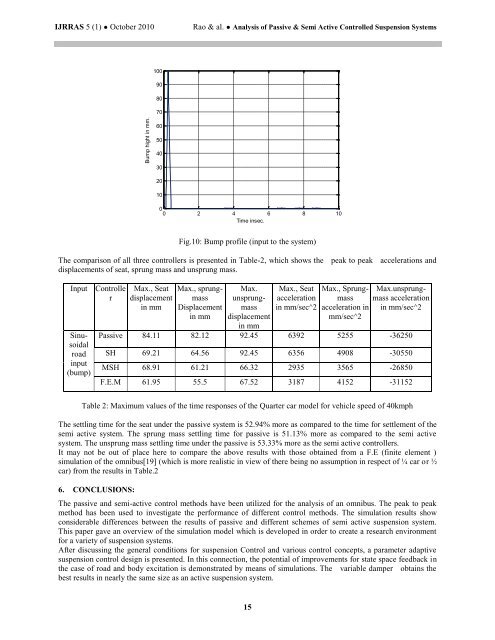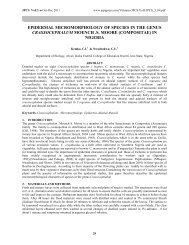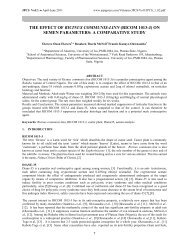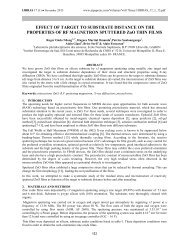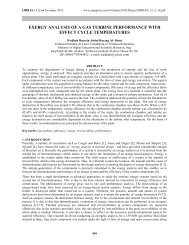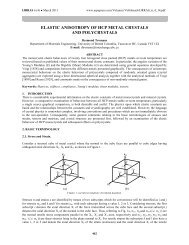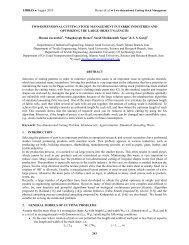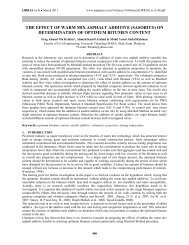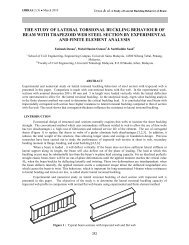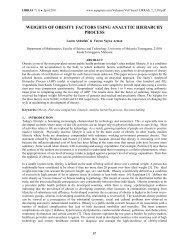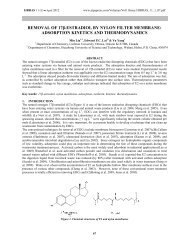Comparison between Passive and Semi Active Controlled Suspension
Comparison between Passive and Semi Active Controlled Suspension
Comparison between Passive and Semi Active Controlled Suspension
Create successful ePaper yourself
Turn your PDF publications into a flip-book with our unique Google optimized e-Paper software.
IJRRAS 5 (1) ● October 2010 Rao & al. ● Analysis of <strong>Passive</strong> & <strong>Semi</strong> <strong>Active</strong> <strong>Controlled</strong> <strong>Suspension</strong> Systems<br />
Bump hight in mm.<br />
100<br />
90<br />
80<br />
70<br />
60<br />
50<br />
40<br />
30<br />
20<br />
10<br />
0<br />
0 2 4 6 8 10<br />
Time insec.<br />
Fig.10: Bump profile (input to the system)<br />
The comparison of all three controllers is presented in Table-2, which shows the peak to peak accelerations <strong>and</strong><br />
displacements of seat, sprung mass <strong>and</strong> unsprung mass.<br />
Input Controlle<br />
r<br />
Sinusoidal<br />
road<br />
input<br />
(bump)<br />
Max., Seat<br />
displacement<br />
in mm<br />
Max., sprungmass<br />
Displacement<br />
in mm<br />
Max.<br />
unsprungmass<br />
displacement<br />
in mm<br />
15<br />
Max., Seat<br />
acceleration<br />
in mm/sec^2<br />
Max., Sprungmass<br />
acceleration in<br />
mm/sec^2<br />
Max.unsprungmass<br />
acceleration<br />
in mm/sec^2<br />
<strong>Passive</strong> 84.11 82.12 92.45 6392 5255 -36250<br />
SH 69.21 64.56 92.45 6356 4908 -30550<br />
MSH 68.91 61.21 66.32 2935 3565 -26850<br />
F.E.M 61.95 55.5 67.52 3187 4152 -31152<br />
Table 2: Maximum values of the time responses of the Quarter car model for vehicle speed of 40kmph<br />
The settling time for the seat under the passive system is 52.94% more as compared to the time for settlement of the<br />
semi active system. The sprung mass settling time for passive is 51.13% more as compared to the semi active<br />
system. The unsprung mass settling time under the passive is 53.33% more as the semi active controllers.<br />
It may not be out of place here to compare the above results with those obtained from a F.E (finite element )<br />
simulation of the omnibus[19] (which is more realistic in view of there being no assumption in respect of ¼ car or ½<br />
car) from the results in Table.2<br />
6. CONCLUSIONS:<br />
The passive <strong>and</strong> semi-active control methods have been utilized for the analysis of an omnibus. The peak to peak<br />
method has been used to investigate the performance of different control methods. The simulation results show<br />
considerable differences <strong>between</strong> the results of passive <strong>and</strong> different schemes of semi active suspension system.<br />
This paper gave an overview of the simulation model which is developed in order to create a research environment<br />
for a variety of suspension systems.<br />
After discussing the general conditions for suspension Control <strong>and</strong> various control concepts, a parameter adaptive<br />
suspension control design is presented. In this connection, the potential of improvements for state space feedback in<br />
the case of road <strong>and</strong> body excitation is demonstrated by means of simulations. The variable damper obtains the<br />
best results in nearly the same size as an active suspension system.


